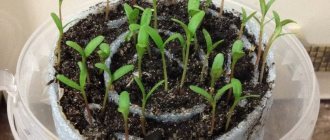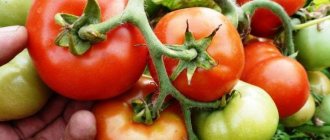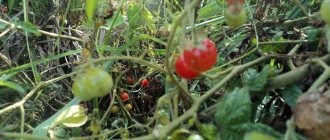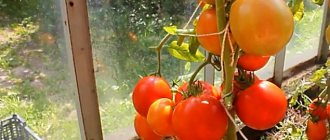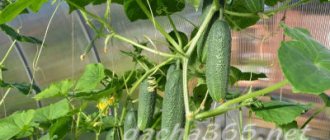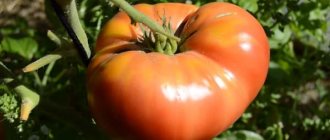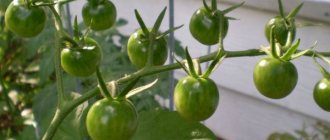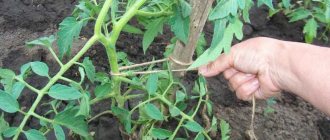In cold summers, tomatoes often do not have enough heat and sunlight to ripen naturally on the bushes. This problem is especially relevant for residents of regions with cold climates, where more than half of the tomatoes simply do not have enough time to fully ripen. In this case, the tomatoes are removed from the bush and sent for ripening at home. Gardeners use several simple and effective methods of ripening, which allow them to obtain ripe fruits that are not inferior in taste to tomatoes ripening on the bushes.
When and how to remove tomatoes from the bush for ripening
There is no exact time for harvesting tomatoes for ripening. It depends on the climate and weather conditions of the region. Often already in August there is cold and rainy weather, which threatens the development of tomato late blight. In this case, you should not hesitate to remove the fruits.
Tomatoes from the bushes should be removed for ripening before the air temperature drops below +5°C. Depending on weather conditions this is mid or late August. Tomatoes should not be allowed to freeze - this causes late blight. In addition, frozen fruits immediately spoil and cannot be stored for a long time.
Stages of tomato maturity by color:
- green;
- blanzhevy – at this stage the fruits are beige or yellowish-brown in color;
- red, pink or yellow - stage of ripeness.
If the tomatoes are still green, but have already reached the size indicated in the varietal characteristics, and fully ripened seeds are visible at the cut site, such fruits can already be removed from the bush and sent for ripening.
Very small tomatoes can be left on the bush, since under artificial conditions they will not be able to fully ripen.
Rules for collecting tomatoes:
- Tomatoes are usually picked from the bush every 4-6 days as the fruits ripen. Tomatoes should not be allowed to overripe - soft fruits are not suitable for long-term storage; they are eaten immediately.
- Fruits should be collected only in dry weather, preferably early in the morning, but after the dew has completely dried. It is most convenient to cut tomatoes with garden shears along with the stalks. This will ensure longer storage of the crop.
- Tomatoes must be removed from the bush very carefully, trying not to damage the thin skin. Such damage and microcracks can cause the development of rot and pathogenic bacteria and will significantly reduce the shelf life of the crop.
Common mistakes
During the ripening process, summer residents often make mistakes that lead to damage to the crop:
- placing wet fruits in a box. Before stacking, each tomato must be carefully wiped;
- use of damaged tomatoes. Damaged specimens are not used for ripening;
- storing tomatoes in a cold place. In order for the fruits to fully ripen, it is necessary to maintain a temperature of at least 15 degrees. Otherwise, the fruits will not turn red.
Often, gardeners, having collected unripe tomatoes, leave them to ripen on the balcony. However, as a result, the tomatoes lose their flavor and become limp. If a box of tomatoes is stored on the balcony, it must be insulated with at least a blanket.
What tomatoes can be ripened
For home ripening, you can use both green and blanc tomatoes, taken from the bush at the stage of milky ripeness. As their name implies, they have a whitish-beige color.
Typically, the size of such fruits already corresponds to the declared characteristics. After ripening at home, they acquire a rich, full-fledged taste and aroma, and the seeds of such tomatoes can be used for growing next year.
Carefully inspect the tomato - if its skin has a slight glossy sheen, this indicates early ripening. You can also select several fruits and cut them. If their seed chambers are empty, it is too early to harvest such tomatoes for ripening. They will not be able to fully ripen at home.
Blanche tomatoes ripen the fastest. They can be identified by their beige or yellowish-brown color. The pulp has a pink tint when cut, as it is already beginning to ripen. In most cases, it takes no more than 6-7 days for blanzhe tomatoes to fully ripen.
Should I pick green tomatoes?
Should I pick green tomatoes or let them grow and turn red on the bush? The answer is clear: “Yes, pick it!”, because:
- in the bunch of tomatoes there are always a couple of already saturated tomatoes, ready to turn red, and two or three smaller ones, at first glance, lagging behind their fellows in development. By picking one or two tomatoes in a bunch of milky ripeness and sizes suitable for the variety, we thereby give the rest the opportunity to “get to condition”
- under its own weight, the lower brush falls and often the lower tomatoes touch the ground. To protect tomatoes from late blight, gardeners remove all the lower leaves, the same applies to the fruits: they need to be either lifted and hung or picked. It is better to pick green tomatoes completely in the lower cluster, even if there are small ones, because sap flow through the plant goes from bottom to top and while there is a lower cluster, the upper ones receive less nutrients and are slow in their development.
As soon as you pick green tomatoes in the lower zone of the plant, you immediately see a positive result in the trusses located above: the tomatoes grow larger “before your eyes.”
Conditions and terms of storage of tomatoes for ripening
The main condition for ripening tomatoes is the correct temperature. The warmer the room, the faster the tomatoes will ripen. But the temperature in the room should not be allowed to be too high - small tomatoes will quickly wither before they have time to ripen, and large ones will turn red but remain tasteless.
In some cases, summer residents need to allow picked tomatoes to ripen as long as possible, until the end of autumn. To do this, the crop is left in a dry and cool room.
Conditions for proper ripening of tomatoes:
| Conditions | Peculiarities |
| Air temperature | From +15°С to +25°С |
| Lighting | Bright for fast ripening, partial shade for slow ripening |
| Air humidity | 70-80% |
| Ventilation | The room must be regularly ventilated |
Tomatoes can be ripened both in bright light and in the dark, but in the first case the process will develop much faster. You should not leave fruits in direct sunlight for a long time, as they quickly overheat, soften, lose their elasticity and begin to rot.
Before storing tomatoes for ripening, they need to be properly prepared. First of all, sort the crop by degree of maturity and size, immediately discard all fruits with traces of disease and damage.
Only completely healthy tomatoes are used for ripening. They should be free of rotten and dark spots, traces of late blight and damage by insect pests.
After this, clean healthy tomatoes from soil particles with a soft cloth and send them for further ripening. If the tomatoes were picked in rainy weather, rinse them and dry them thoroughly. They can be transferred indoors for further ripening only dry.
The ripening time of tomatoes depends on the method used. For traditional aging indoors, it will take 15-20 days, for layer-by-layer aging – up to 40 days. Blazing tomatoes ripen faster than others; this will take no more than 5-8 days.
What not to do while tomatoes are ripening
Water generously. Tomatoes do not like sudden changes in humidity. Do not let the soil dry out and then water it generously. This causes the fruits to crack. It is better to mulch the soil under the tomatoes with hay. Under mulch, moisture is retained much longer, the earth does not crack from the heat and does not become crusty.
There are also special bacteria in hay that prevent the late blight pathogen from multiplying. During fruiting, it is better not to water tomatoes.
Feed with nitrogen. From the second half of summer, tomatoes cannot be fertilized with nitrogen in any form. Mullein, chicken droppings, infusion of green mass, and mineral nitrogen fertilizers are not used.
Tomatoes will intensively grow green mass, not fruits. And such fertilizing also worsens the taste of the fruit. Even if your climate allows you to grow tomatoes until late autumn, still apply only potassium-phosphorus fertilizers.
Where and how to ripen tomatoes correctly
There are several ways to ripen tomatoes at home. They can be ripened in a warm and dry room, on bushes, or in layers. All methods of artificial ripening of tomatoes are easy and simple, so even a novice vegetable grower can use them.
Classic ripening
The classic way to ripen tomatoes is in a warm and well-ventilated area. Place the sorted tomatoes on a flat surface, on shelves or tables lined with clean paper or newspapers. The layer of fruit should be uniform, no higher than 15-20 cm in height. You should not place tomatoes on the windowsill, as this will expose them to direct sunlight.
For classic ripening, tomatoes require an air temperature in the range of +20-25°C, good, bright lighting, good ventilation and low air humidity. In such conditions, after 15-20 days the tomatoes will be completely ripe.
Every 4-5 days you need to carefully inspect the tomatoes and turn them over to the other side - this way the color of the fruit will be uniform. Do not forget to remove ripe fruits, as well as discard those that show signs of damage or late blight.
Layer ripening
Layer-by-layer ripening is excellent if the harvest is very rich, but there is little space for its ripening. For layer-by-layer ripening of tomatoes, you can use cardboard or wooden boxes, large pans or baskets. Place several layers of newspaper or thick paper on the bottom of the containers.
Place the green fruits in the selected container in layers, sprinkling each of them with sawdust or laying them out with sheets of paper. In this way, fill the container to the very top.
Cover the box with a cloth or cover it with a lid - but not too tightly, air should flow to the tomatoes. The air temperature for rapid ripening of tomatoes is no higher than +15°C. Layer-by-layer ripening of the harvested crop will take at least 30 days.
Ripening on the bushes
To ripen tomatoes on bushes, dig up the plants along with the root system and carefully shake off soil particles. Tie a thread or string to the roots and hang the tomato plant in a warm and well-ventilated area.
When hanging bushes, make sure that the tomato bushes do not touch each other, otherwise oxygen access to the roots will deteriorate. When the bushes are suspended in this way, all the nutritional elements from the roots, leaves and stems are directed to the fruits, due to which they quickly ripen and become large.
Ripening "in a stack"
Among gardeners, the “stacked” method of ripening tomatoes is very popular. To do this, cut the tomato bushes at the surface of the soil and stack them, without removing the fruits, in a stack no less than 45-55 cm high.
The tops of tomato bushes should be directed towards the center of the stack. Leave the tomatoes in a warm and dry room or outside, under a canopy - but in this case it is advisable to cover them with spunbond or other non-woven material. If this is not available, you can use straw.
You can ripen tomatoes on the bushes in another way - dig up the plants along with the roots and place them in wooden or cardboard boxes without removing lumps of soil from them. Leave the tomatoes to ripen in the greenhouse or take them out onto the veranda.
If it's cool in the greenhouse or on the veranda, cover the tomato bushes with a layer of straw. Every 5-6 days, water each bush at the root, picking off the already reddened fruits.
Preparing tomatoes
Collected fruits require certain preparation for ripening.
- The first step is to reject fruits that have mechanical damage and are affected by late blight. Such vegetables are sent for processing.
- It is advisable to sort healthy fruits by degree of ripeness and size, since, as a rule, large fruits ripen first, followed by smaller ones.
- To prevent tomatoes from rotting, some gardeners keep them in an open oven for about three hours at 40 degrees. To prevent late blight, tomatoes are dipped in a raspberry solution of potassium permanganate for a couple of minutes. The latter can be replaced with 60-degree water. In any case, the fruits are wiped dry after the procedure and left to ripen.
Important: high temperature is a detrimental factor for fungal spores found on vegetables.
Novice gardeners often wonder whether they need to wash tomatoes picked for ripening. Experienced farmers do not recommend doing this, but there will be no big harm from washing the fruits if you wipe them dry afterwards.
How to speed up the ripening of tomatoes
Experienced vegetable growers use small tricks to help speed up the ripening of tomatoes using any ripening method.
- Place ripe red tomatoes (3-5 pcs) in a basket or box with green tomatoes. Ripe fruits produce ethylene, a special gas that stimulates redness and ripening of tomatoes.
- Add 3-4 bananas or red apples to the box with green tomatoes - they effectively speed up the ripening of tomatoes.
- Move boxes or other containers with green tomatoes to a room with an air temperature of at least +28°C. In such conditions, the fruits ripen much faster.
- Place the green fruits in direct sunlight - but in this case, you need to regularly turn the tomatoes and make sure that they do not start to wilt in the sun.
- Place the tomatoes in a box or basket in layers, sprinkle each of them with loose tea. According to many summer residents, this unusual method helps to get red, tasty tomatoes in just 2-3 days.
Many summer residents use an original way to speed up the ripening of green fruits - they cover a box or other container with the harvested crop with a thin red cloth. It has been noted that under such a “shelter” tomatoes ripen much faster and have a good, rich taste.
Traditional way
To send for ripening, you need to select tomatoes of the following degree of maturity:
- milky - characterized by the appearance of a light gloss on the surface of a green tomato;
- brown – the sides turned towards the sun acquire a light brownish tint;
- pink – the first redness appears on the skin of the fruit;
- red - the tomato acquires an even red tint, but remains dense inside.
It is recommended to collect fruits no later than the period when the temperature at night remains stable at around +10 degrees. At lower temperatures there is a risk of developing late blight in tomatoes.
To ripen tomatoes using the time-tested traditional method, you will need to prepare containers - wooden or plastic boxes, which are placed in a well-ventilated room that is not subject to frost. Between the unripe fruits, several tomatoes are placed that have already reached their final degree of ripeness. They produce ethylene, a substance that speeds up ripening.
It will be enough to place 2-3 ready-made fruits so that the effect does not take long to appear. For greater efficiency, it is worth covering the drawers with newspaper, not forgetting that there should be gaps for ventilation. The humidity in the room should be average, and the temperature should be about 20-25 degrees above zero.
Once a week, tomatoes must be checked and rotting specimens removed in a timely manner.
How to slow down the ripening process
In some cases, a summer resident needs to stop the ripening process of tomatoes - for example, when collecting too many fruits. By following a few simple rules, you can preserve tomatoes and postpone their ripening until the first autumn cold.
- Only green tomatoes are suitable for slow ripening;
- the air temperature in the room where tomatoes are ripening should not be higher than +12°C;
- the best option for long-term ripening of tomatoes is a cool cellar or basement with low air humidity;
- boxes of tomatoes should be kept away from potatoes, bananas and apples;
- Instead of boxes, you can ripen tomatoes in plastic bags, hanging them from the ceiling or supports - but the top part of the bag does not need to be closed so that there is normal air circulation.
From time to time, inspect all the fruits and remove the reddened ones from the total mass, as they will speed up the ripening of the remaining tomatoes.
The slow ripening method has one drawback - a large number of rotten fruits, which is much more than with normal ripening of tomatoes.
In regions with short summers and cold climates, vegetable growers often have to resort to various methods of ripening green tomatoes at home, because the fruits simply do not have time to fully ripen in the garden. Various methods are used for this - they can be left to ripen in a warm room, laid out in layers, ripened on a bush or in stacks. Using simple and effective options, you can get large, red and tasty fruits that will delight you with a rich taste right up to the winter frosts.
Why pick unripe tomatoes?
In reality, there are more reasons than might seem at first glance. Among the most common:
- modern high-yielding varieties can produce more fruit than the branches can bear. Large, fully formed green tomatoes are removed, allowing the remaining ovaries to reach the size specified in their genotype;
- Frequent harvesting of fruits increases productivity, as the plant strives to achieve its main goal - to produce ripened seeds;
- as soon as the first frosts arrive and night temperatures drop to +10°C, it makes sense to collect unripe fruits so as not to expose them to the danger of freezing;
- With the autumn cooling, the threat of late blight returns, causing both bushes and tomatoes to suffer.
There is another reason to collect and store unripe crops. In canned form, it is a popular, tasty and healthy type of preparation for the winter. Part of the harvest with minor damage is usually immediately put into pickling, leaving only the most attractive and intact fruits for ripening.
